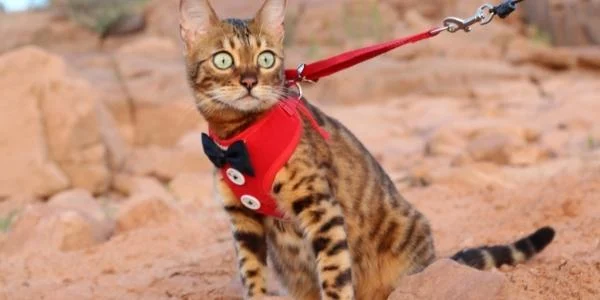Introduction
Cats are known for their independent nature, often exploring the world around them with curiosity and grace. While many cats are content with indoor living, some may benefit from supervised outdoor adventures. This is where a cat harness becomes an invaluable tool for responsible cat owners.
A cat harness allows you to safely take your feline friend for a walk, providing them with mental stimulation, exercise, and a chance to experience the outdoors in a controlled environment.
In this guide, we’ll delve into the importance of using a cat harness and provide essential safety tips to ensure a secure and enjoyable walking experience for your cat. We’ll explore the various types of cat harnesses available, discuss how to properly fit and adjust them, and offer advice on introducing your cat to the harness for the first time.
Why Use a Cat Harness?
Before delving into the safety tips, it’s crucial to understand why one should buy cat harness. Unlike dogs, which can be walked on a leash attached to a collar, cats have more delicate necks and can easily slip out of a collar. A cat harness, on the other hand, distributes pressure evenly across the chest and back, minimizing the risk of injury and escape.
Moreover, a cat harness provides you with better control over your cat’s movements. It allows you to guide them away from potential dangers, such as traffic, toxic plants, or other animals. Additionally, a harness can prevent your cat from climbing trees or fences, which could lead to them getting stuck or injured.
Types of Cat Harnesses
There are several types of cat harnesses available on the market, each designed to cater to different preferences and needs. The most common types include:
H-Style Harnesses: These harnesses form an ‘H’ shape over your cat’s back and chest. They are known for their secure fit and are ideal for cats that tend to pull or escape.
Vest-Style Harnesses: These harnesses resemble a vest and offer a snug, comfortable fit. They are excellent for cats that are new to harness training and may feel more secure in a close-fitting garment.
Figure-Eight Harnesses: These harnesses loop around your cat’s neck and body, creating a figure-eight shape. They provide a secure fit without putting pressure on the neck.
Escape-Proof Harnesses: Designed with multiple security features, these harnesses are ideal for cats that are especially adept at wriggling out of standard harnesses.
Properly Fitting Your Cat Harness
Ensuring a proper fit is paramount for your cat’s safety and comfort during walks. Follow these steps to find the right size and adjust the harness accordingly:
Measure Your Cat: Use a soft tape measure to determine your cat’s girth (the widest part of their chest) and neck circumference. Compare these measurements to the sizing chart provided by the harness manufacturer.
Adjust Straps: Once you’ve selected the appropriate size, adjust the straps to achieve a snug but not constricting fit. You should be able to slip two fingers between the harness and your cat’s skin.
Check for Movement: After securing the harness, gently tug on it to ensure it doesn’t shift or twist. The harness should stay in place even when your cat moves.
Introducing Your Cat to the Harness
Introducing a cat to a harness requires patience and positive reinforcement. Here’s a step-by-step guide to help your cat become accustomed to wearing a harness:
Start Indoors: Begin by letting your cat explore the harness in a familiar and comfortable environment. Allow them to sniff, paw at it, and become accustomed to its presence.
Gradual Introduction: Slowly acclimate your cat to the harness by placing it on them for short periods. Offer treats and praise to create positive associations.
Practice Indoors: Once your cat seems comfortable, attach a leash and let them walk around indoors. Keep the sessions short and positive.
Transition to Outdoors: When your cat is confident in the harness, venture outside to a secure and quiet area. Allow them to explore at their own pace while keeping a watchful eye on their reactions.
Additional Safety Tips
Choose the Right Environment: Start in a quiet, enclosed area with minimal distractions. Avoid busy streets or areas with loud noises.
Avoid Extreme Weather: Harsh weather conditions, such as extreme heat or cold, can be uncomfortable or even dangerous for your cat. Choose pleasant, mild days for walks.
Stay Vigilant: Keep a close eye on your cat’s body language. If they seem distressed or anxious, end the walk and try again another time.
Bring Supplies: Carry essentials like water, treats, waste bags, and a first-aid kit in case of any unexpected situations.
Conclusion
When you buy cat harness and use it is a wonderful way to enrich your cat’s life while ensuring their safety during outdoor adventures. By selecting the right harness, fitting it properly, and introducing it gradually, you can provide your cat with a secure and enjoyable walking experience. Always prioritize your cat’s comfort and well-being, and cherish the moments of shared exploration with your feline companion. With these cat harness safety tips, you’ll be well-equipped to embark on many delightful adventures together.
